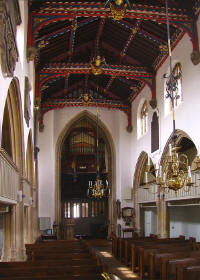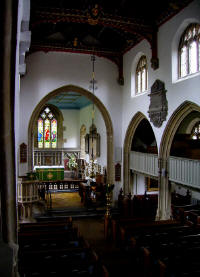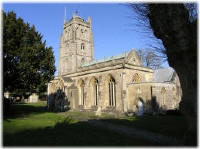|
Churches which still retain west gallery
features or connections |
|
Babbington, St Margaret |
The mid-18th C. church and manor house form a
charming group away from all other habitations. The church is the most
completely unaltered Georgian example in Somerset. Apsidal sanctuary and small
west tower with octagonal cupola. The interior has good moulded plaster work on
the roof and apse. Box-pews, curved holy table, gated altar rails, two-decker
pulpit, pedestal font and clear glass. (CEPC) |
|
Bagborough, St Pancras |
Said to be rich in fittings of the Georgian
period. No further details known. |
|
Banwell, St Andrew
|
Mainly 14th C. core, but with 15th C. and later
additions. The west gallery is said to have been made from an Elizabethan
manorial pew. (CEPC)
There is also a porch
gallery. |
|
Bath, Larkhall, St Saviour,
|
Gothic revival church of 1829-32. Impressive late
Georgian attempt at Somerset Perpendicular style; galleried interior,
Victorianised in 1882. |
|
Bath, Walcot, St Swithun, |
Rebuilt in 1777-80 by John Palmer, tower and
spire 1790. Ionic classic design, interior galleried and with free-standing
Ionic columns; monuments; Victorian pews; shallow chancel. (CEPC) |
|
Berrow,
dedication not known
|
The Jacobean beam now at the west end of the
south aisle was probably the supporting beam of a minstrels' gallery that was
once at the west end. The inscription on the front of the gallery read: |
| |
|
|
| |
I was set up right and even
1637. |
|
| |
They are of the Lord acurst
that in |
|
| |
theyr delings are not
just. |
|
| |
|
|
|
The initials of churchwardens are also
appended.
A door beneath the west window gave external access to
gallery. |
| |
|
|
| |
Accounts - 1778 |
|
| |
Bought - a bass viol and an hautboy. |
|
| |
|
|
|
|
Cameley, St James |
An isolated church next to a farmhouse, it is of
12th C. origin but refashioned in the 15th C. Internally there are white walls,
clear glass in the windows, box-pews, canopied pulpit, gated altar-rails and
galleries. (CEPC)
The gallery with turned
balusters dates from 1711 and there is a second gallery dating from 1819, both
with wooden hat-pegs, and reached by an external stone stair. The 1819 gallery
was "for the free use of the inhabitants." (NB the font cover was made in 1634
for £1.12s 4d) #
The parish church is
dedicated to
St. James and dates from the late 12th century. The tower,
probably from the 15th century with 19th century restoration,
built of red Mendip stone contrasts with the local blue lias
limestone of the rest of the church. There are fragments of
wall paintings on the nave north and
south walls. Fragments from the 12th to the 17th century have
been identified, the most impressive being the fine early 17th
century Ten Commandments over the
chancel arch, framed in twining leaves with cherubs' faces
peering out. The west gallery is dated 1711 but with
Jacobean style
balusters and attached Charles !
coat of arms. The south gallery is dated 1819. There
are 2 early 19th century monuments to the Rees-Mogg family on
nave north wall . . . (Wikipedia) |
|
Catcott, dedication not known
|
Has west gallery of very simple
type, other fittings, benches with some hinged child seats,
communion rail, table, font cover, reading desk, pulpit, painted texts, royal
arms, text boards. 17th/19th cent date. Mediaeval church,
aisleless. The Victorians tampered with the chancel. - Info
from Phillip Shepherd
|
|
Churchstanton, St Peter & St Paul |
Some way out from its village, the church is in
typical West Country Perpendicular style, largely refitted ca. 1800.
|
|
Croscombe,
Blessed Virgin
Mary |
Mostly 15th and 16th C, , with a stone spire.
Interior largely refitted in early 17th C., with lofty screen, canopied pulpit
and box-pews. (CEPC) |
|
Ditcheat, St Mary Magdalene |
Has a 17th C. reading desk. |
|
East Brent, St Mary Magdalene |
Mainly 15th C., with a stone spire, , but has a
wooden lectern, and a 17th |C. pulpit and gallery. (CEPC)
Gallery is dated 1635. It was originally
on the site of (supported by ?) the mediaeval rood screen. 1824 carpenter's
bill: "Removing Gallery to west end . . . putting up the partition at the back
of the Gallery and over where the old Gallery stood . . . A Gothic screen
between the Church and Chancel measuring 169 ft . . . Altering and framing part
of the front of the Gallery and making framing to match with carved rails,
panels etc." (Source?) |
|
Evercreech, St Peter |
OS grid ST6438 :: Geograph British Isles
Church dates from 14th - 15th C., tower and nave
roof 15th C. The west gallery "looks to be made up from the timbers of the old
rood screen" (Guide book).
The galleries were added in the 1840s.
Painted Angel roof

|
|
Goathurst,
St Edward |
The church, as it is now, dates
from the 15th to 16th century and is mainly of the
Perpendicular Period. A beautiful quite simple building of
rough rubble walling of the local stone. The quoins and
mouldings are mainly Ham stone with reconstituted
pieces of Blue Lias. (Goathurst website)
But Goathurst, a small Somerset
village under the Quantocks, is fortunate in possessing not
only the complete music library of its west- gallery choir,
but an exceptionally full series of church-wardens' accounts,
from which the history of the band can be traced. . . . there
is no mention of any music in any form until 1786, when a
modest 2s is paid for 'a pitch-pipe for the Galerey' . . .
( Donald MacArthur in the Musical Times, Vol.
64, No. 962 (Apr. 1, 1923), pp. 264-267
Is this
still there??? |
|
Holcombe, St Andrew |
The church now stands a mile away from the
village, which moved and now has its own Victorian church. 12th C. origins,
refashioned in 16th C., and later. Interior if very much of one period, with
box-pews, hat pegs, two-decker pulpit, west gallery and clear glass.
(CEPC)
"Unrestored and atmospheric". #
|
|
Ilminster, St
Mary |
One of the greatest of Somerset churches. Mainly
15th C. and of cruciform plan, with central tower and elaborate north transept.
The nave arcades were rebuilt and aisles raised to accommodate galleries. . . .
Note also, fan vault of tower, 17th C. Jacobean pulpit and screen and 18th C.
chandelier. (CEPC) |
|
Larkhall, Bath, St Saviour |
See above. |
|
Limpley Stoke, dedication not known |
The church has a 17th C. west gallery, but no
other details known. |
|
Lopen,
All Saints |
Hidden behind the Schoolhouse. A
simple two-celled church with bellcote, extended by a
north transept in 1834. Rather charming inside with
a west gallery but the
gallery in the north transept has
vanished (there is an external stair and doorway).
Also, an old font, 17th Century communion rails,
reconstructed (2002) Roman pavement,
and a large transept of 1834 (complete with
door for a now-vanished gallery). On one wall, half
hidden by the pulpit, a coloured
slate incised tablet (of a kind more
usually found in Cornwall).
See photos at
http://www.flickr.com/photos/churchcrawler/491638143/,
courtesy Phil Draper, (Churchcrawler). |
|
North Petherton, St Mary |
Mainly 15th C., with a superb tower. Gallery
dated 1623, and a 17th C. manorial pew. (Are these one and the same??) |
|
Pawlett, St John Baptist |
Has a 12th C. core, refashioned in 13th and 15th
C. A fine display of 17th C. fittings - three-sided altar-rails, box-pews, font
cover, pulpit and reading desk. Windows mostly have clear glass. |
|
Rodney Stoke, dedication not known
|
West gallery. 1625 screen with open balustrade.
|
|
St
Audries, St
Ethelburga |
Now has the 1772 Barrel Organ
originally at Kilton Church, Somerset. |
|
Seavington,
St Michael |
Set
in a churchyard a lot higher than
the road. At the west end an original stone
bellcote with a timber-framed
extension added to the east,
presumably to house additional bells. Inside
is a west gallery, old font, effigy
of a civilian against the chancel
wall, Charles II Royal Arms and two old figures in
glass. Panelled chancel arch (unusual - normally it is
the tower arch that is so).
Photos courtesy Phil Draper, (Churchcrawler). |
|
Selworthy, All Saints |
A typical West Somerset 15th C. church with
plastered walls and squat west tower. Within are rich wagon-roofs, mediaeval
and Comper glass, carved bench-ends, 15th C. pulpit with 17th C. tester, 18th
C. west gallery, manorial pew and monument by Chantrey. . .
(CEPC)
Picture Phil Draper |
|
Shepton
Mallet, Unknown |
Small chapel
with box pews and two harmoniums (harmonia?). Exact location
unknown. |
|
Stawley, St Michael |
One of the few churches in this area of Somerset
which escaped the Victorians. 13th C. fabric and mostly 18th C. fittings, which
include box-pews, altar-rails, pulpit with domed tester and clear glass in the
windows. (CEPC) |
|
Sutton Mallet, unknown
dedication |
A little church, highly" atmospherick", rebuilt
in 1829. It retains its box-pews, gated altar-rails, three-decker pulpit and
west gallery. (CEPC) |
|
Swell, St Catharine
|
12th C. origin, recast in the 15th C. It retains
its 17th C. altar-rails, font cover and pulpit, together with the 18th C.
box-pews. |
|
Timsbury,
St Mary |
The ancient
church fell into disrepair in the 1820s and it was pulled down
and rebuilt in the Gothic style in 1826. Rev Barter was a
great benefactor to the new church, but unfortunately he died
before it was finished. Rev John Skinner (Rector of Camerton
and diaryist) records in 1825
“Poor Barter had hoped to live to witness the completion of
the new church at Timsbury… but this was not to be.”
The new church
consisted then of a nave and chancel, built from designs by
Sir George Gilbert Scott, the leading European architect who
designed Westminster Abbey and the Albert Memorial. In fact,
the existing road had to be moved to accommodate the new
chancel. Side aisles were added in 1852, when the square
benches, side galleries were taken away (evidence of the
fixing points are still visible on the outside walls), and the
organ was also moved to the north side aisle.
(quotes from church website:
http://www.stmarystimsbury.org/History.htm ) |
|
Tintinhull, St Margaret |
Jacobean pulpit with tester. |
|
Watchet, St Decuman |
17th C. pulpit with tester. |
|
Weston-in-Gordano, dedication not known
|
The church has a porch gallery. |
|
Wiveliscombe, St Andrew |
The church was rebuilt in 1829, and has been
described as a "tasteless building with a showy semi-Italian interior". It is
nothing of the sort, being in fact a most interesting structure in a free
rendering of \Perpendicular, and has of late been relieved of certain Victorian
blemishes which had intruded and has now a delightful interior. Box-pews, gate
altar-rails and a west gallery. . . . (CEPC) |
|
Wyke Champflower, Holy Trinity |
A small aisleless parallelogram, attached to the
manor house. It was rebuilt in 1623 in Jacobean Gothic. It has entirely escaped
Victorian 'restoration'. Box-pews, hat-pegs, altar-rails, holy table and
pulpit. (CEPC) |
|
|
|
|
|
|
|
Churches which are known to have had west
gallery features or connections |
|
Backwell, St Andrew |
The church had wooden gallery over the south
door. |
|
Barrington, dedication not known |
The west gallery was removed in 1860 (along with
communion table, rails, pulpit, reading desk, font, pews, chancel and transepts!) |
|
Berrow, dedication not known |
Has a beam from the west gallery of 1637, which
had external access via a door beneath the west window and was removed in 1885.
(NB 1631 prayer desk; pulpit had 1621 on original base, all replaced in 1885.)
See above. See above. |
|
Chew Magna, dedication not known |
Had a singing gallery in the late 14th C. porch.
|
|
Blackford, St Michael |
Near Wincanton, this church
once had a west gallery. |
|
Croscombe, St Mary |
Organ installed in west gallery in 1837; gallery
removed 1860. See above. |
|
Freshford, dedication not known |
North gallery built 1738 due to lack of seating;
had external stair. Ca.1800 the north aisle was extended eastwards, also
with a gallery but with an internal stair. Well into the 19th C., a man was
paid 10s. per annum for keeping order in the gallery. In 1859 the west gallery
"for the singers" removed. In 1868 an organ was obtained. In 1910 the north
galleries were removed, and the organ placed in gallery under west tower. In
the 1930s the organ was moved and choir moved from the rear of the church and
robed. |
|
Glastonbury, St John Baptist |
Before 1856 two western bays of the nave were
filled with a gallery with an organ. (Also removed at that date were the oak
pulpit and tester, oak panelled box pews, benches at the back for the poor, and
pews for mayor and corporation.) |
|
Ilminster, St Mary
the Virgin |
In 1824-25 the nave and aisles were raised to
accommodate north and south galleries as well as a west gallery. In 1882 the
north and south galleries were removed and a smaller one at west end was
substituted (still there). Rood loft "used for musicians until 1782 at least."
[?] (Guide book) See above. |
|
Isle Abbots, St Mary |
The musicians' gallery was removed in 1874
. |
|
Otterhampton, dedication not known |
"Rather harsh restoration in 1894" when west
gallery was removed. |
|
Ruishton,
St |
|
|
St
Michaelchurch, St Michael |
The church of ST. MICHAEL
comprises an undivided chancel and nave with north and south
aisles, and a north tower above a porch. The proportions of
the building and part of the north wall of the nave apparently
survive from the 11th century. Some rebuilding took place in
the 15th century at the west end. The east window is of the
15th or early 16th century and in 1840 the church retained
square-headed windows of the same period. (fn.
38) The lay rectors were regularly presented in the 16th
and 17th centuries for failing to maintain the church. (fn.
39) In 1663 it was said to be ruined and to have been so
for some years, and the parishioners received support from the
parishes of the diocese to pay for its rebuilding. (fn.
40) After 1823 a long south transept at the west end of
the nave was removed. (fn.
41) Later in the century north and south aisles of three
bays were built, the north known as the Maunsel aisle and the
south built by Sir Alfred Slade in 1868, (fn.
42) possibly by the architect who was extending Maunsel
House the same year. In 1840 the church had a west gallery
with an outside staircase. (fn.
43) Communion rails dated 1635 were said to have been
removed to the Priory, Chilton Polden. (fn.
44) There is a plain octagonal medieval font. The tower
contains one bell dated 1670, (fn.
45) recast in 1938. (fn.
46) The church possesses a small Elizabethan cup and
cover. (fn.
47) The registers date from 1695 and are complete. (fn.
48) (VCH on line history) |
|
Shepton
Mallett, St Peter & St Paul |
During the early and mid 1800s
the transepts and side chapels were removed, and galleries
were constructed, but these were dismantled in 1966 for safety
reasons. The organ, originally at the west end, was removed to
the north east corner and rebuilt in 1859 enabling the west
windows to be reconstructed in coloured glass in memory of a
previous Rector. Box pews were replaced by the present oak
pews in 1887-9.
 |
|
Taunton, St Mary Magdalene |
North gallery removed in 1845. The first organ
was installed in 1709 on a gallery in the centre of the west tower. |
|
Wells, St Cuthbert |
This town church had a west gallery, but still
retains a rich Carolean pulpit. |
|
West Harptree, dedication not known |
Porch room had window opening into south aisle;
possibly a musicians' gallery. |
|
Wrington, All Saints |
Once had a porch gallery. Similar ones remain at
Banwell and Weston-in-Gordano. Gallery across tower arch, constructed "for the
accommodation of a first and second flute, and the small boys who sing",
removed 1859. |
|
|
|
|
|
Chapels which still retain west gallery
features or connections |
|
Bath, Countess of Huntingdon's Connexion |
The Chapel, which houses the Building Gallery, was commissioned by the Countess of Huntingdon in 1765, as one of many chapels she was to have within her Connexion at the end of her life. The Chapel is a beautiful and highly significant building in Bath, being one of the
extremely few gothic buildings that were built in the predominantly classical era of the 18th century. |
|
|
|
|